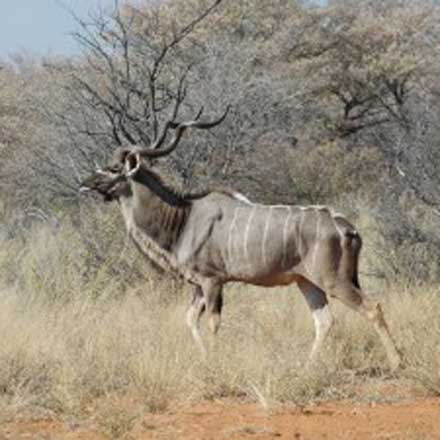
The greater kudu is probably the second-most recognized of the hundred-plus African antelope. Thanks to Chevrolet, the much more common impala is probably the most recognizable, but there’s a big difference. If you’re hunting in an area where impala inhabit, you will probably take one, and he’ll give you a nice trophy—but the impala will be taken along the way, perhaps for camp meat,and maybe for leopard bait. He will rarely be hunted specifically and is almost never near the top of a hunter’s “wish list.” The greater kudu is almost always near the top!
In Hemingway’s 1935 classic, The Green Hills of Africa, professional hunter Philip Percival tells Hemingway, “Everybody wants a kudu.” In today’s Africa, everybody still wants a kudu! The most common, most available, and most economical safari today is the plains game safari, probably lasting seven to ten days, probably in South Africa or Namibia, possibly in Zimbabwe. Between the three countries, there are more than 10,000 plains game safaris conducted annually, and for the majority of those hunters, the greater kudu is the most desired trophy.
This is as it should be. The greater kudu, Tragelaphus strepciseros, is a spectacular creature, that is fawn to iron grey in background color, with four to twelve vertical white side stripes, and a white nose chevron. A throat ruff of longer black and white hairs is matched by a similar dorsal crest. The ears are huge, and above them rise some of the most spectacular horns in the animal kingdom. These thick, walnut-colored horns twist around a raised keel, describing two complete turns at maturity and ending in polished ivory tips.
Greater kudu are generally measured from base to tip around the spiral. The Holy Grail is usually considered to be 60 inches around the spiral—but very few kudu actually reach this dimension, and very few hunters ever see such a kudu. I’m pretty sure I saw one once in an area where I didn’t have a permit. Although I have taken many greater kudu, I have never taken one that even came close! At full maturity, most greater kudu bulls have horns of perhaps 48 to 52 inches. These are impressive trophies, and bigger bulls are increasingly uncommon.
There are several races with some difference in body size, but the largest, the southern greater kudu, is the most widespread and most commonly hunted. Mature bulls probably run from about 450 to 600 pounds. Occasional specimens are...
larger, and the hornless females are somewhat smaller. Greater kudu are found discontinuously from South Africa’s Cape to Ethiopia, and in isolated pockets as far west as southern Chad. This makes them one of the most widespread of all African antelope, and, as such, they are extremely adaptable, occurring in semi-desert, thornbush, and woodlands. You will find them on flat ground and in heavy riverine cover. But, in my experience, they love hilly terrain best of all. So, if there are hills or mountains in a given area, that’s where I would go to look for a kudu.

The greater kudu’s majesty is almost enough to make him one of Africa’s most desirable trophies. But, to this must be added that, unlike numerous open-country species, the kudu loves thick cover and knows how to use it. He must always be hunted rather than merely encountered and shot, and hunting him can be extremely difficult. This depends on your luck—and also where you are hunting. Part of the mystique of the greater kudu is his legend as the “gray ghost,” a wary, difficult creature—and his pursuit has given us some of Africa’s greatest literature and legend. On the safari that gave us “Green Hills,” Ernest Hemingway finally got his kudu. In the course of the safari, he took lion, buffalo, black rhino, and more, but the kudu was the climax, and the animal he spent the most time in search of.
In 1952, Robert Ruark took his first safari and gave us Horn of the Hunter, in my view still one of the very best reads about Africa. Ruark took lion, buffalo, leopard, and so forth—but he devoted more time and more pages to the pursuit of a kudu—and he never got one. Don’t get me wrong, the greater kudu deserves this kind of attention both in literature and on safari, but he is not the near mythical creature that many of the older books suggest him to be.
This isn’t because they were taking literary license, but it's because they were hunting him in the wrong places. Greater kudu have always been uncommon and very localized in East Africa where the majority of safaris took place clear into the 1970s. The vast majority of modern safaris take place in southern Africa where the greater kudu is not just widespread, but...
is also the most common large antelope. He loves his thick cover, and he has good eyes, keen ears, and a fantastic sense of smell. Once in a while you will simply bump into a great bull and take him easily—but usually you must hunt for your kudu. That’s actually a good thing because trophies that are hard-won, that we worked for, are the ones we remember best. But, there are lots of kudu in those three African countries where most plains game safaris take place, and the vast majority of hunters who put a priority on taking one will be successful.